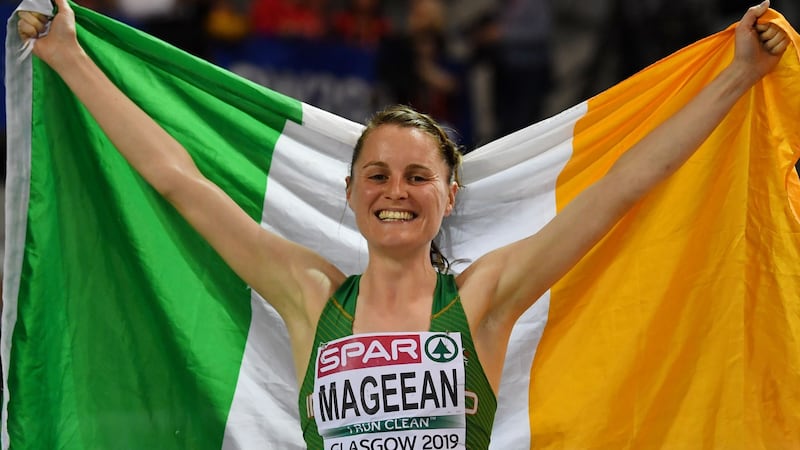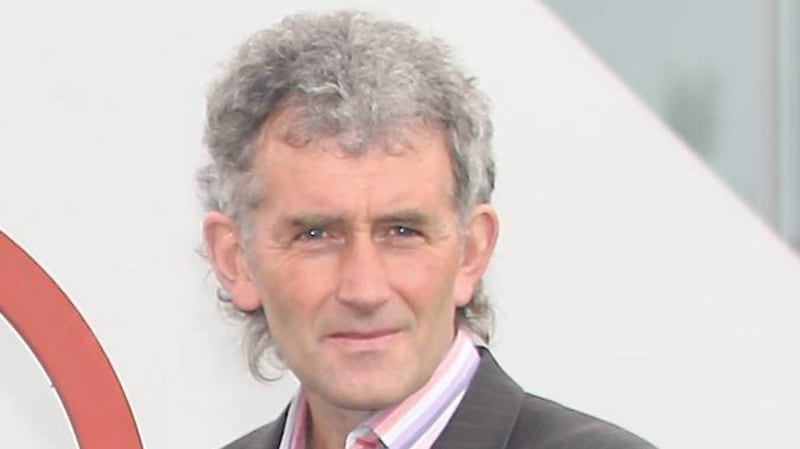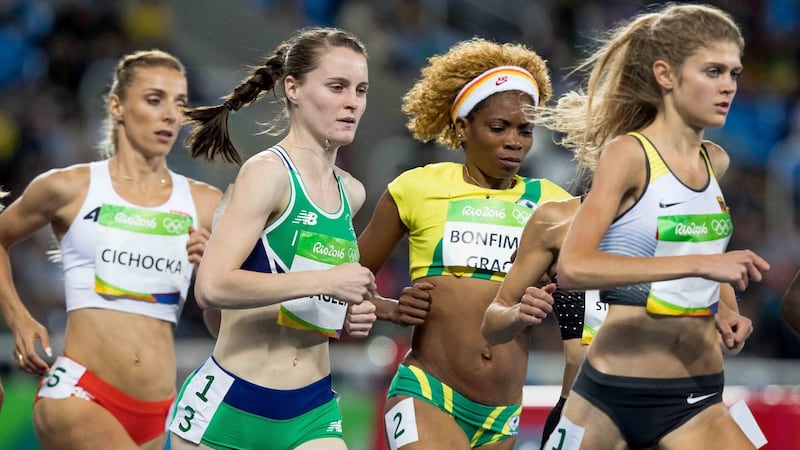She will turn 30 in March and has run races all over the planet without ever once losing the sense that Portaferry, postcard pretty on Strangford Lough, is the unalterable heart of her universe.
We last saw Ciara Mageean on a swampy morning in Tokyo after her 1,500m heat was sabotaged by a light calf tear acquired in her final tune-up session just a week earlier; a minor injury with catastrophic timing.
She spoke about that disappointment on television with her usual striking candour, the tone of voice stayed sing-song bright and tough but there was no disguising the hurt and profound dismay. How many cracks at the Olympics does any athlete get? So Christmas at home was a gorgeous end to an unforgettably bruising year in her life.
Portaferry is a citadel of reliability in a hectic life. It's funny; only when she moved to Manchester, four years ago, did she begin to consider Northern Ireland from the outsider's perspective. And she'll never get used to the blithe indifference towards the North in England.
“They have no concept of the history of the country next to them – nor of their attacks on it,” she marvels. “It is something I find very frustrating, to say the least. I do think it was good for me to move away. But equally, many southerners have no concept of what life is like for northerners. I met people in university in Dublin who told me they have never crossed the Border. I couldn’t get my head around that.”
This is delivered with laughter but there’s a serious point there. Mageean, born 1992, is one of the children of Northern Ireland’s precarious peace process and you don’t have to spend long in her company to understand that she is a vivid representation of the best of the future holds for the place; engaged and progressive and fair-minded.
She is proof that there is no going back. Not so long ago, she posted on Instagram a photograph of Blaney's, a Portaferry institution. It's one of those family -run sweet shops once common to all Irish towns that now seem miraculous.
“You know when you go in as a kid and you feel like you are stepping into Charlie and the Chocolate Factory?” she asks. “That’s Blaney’s. It had wooden little shelves with the sweets on it, the newspaper held up with a piece of elastic to keep them there, it had an amazing smell and all the sweets were in the back in big tubs. And the money till was just a little drawer.

"The two Marys ran it – Big Mary and Wee Mary, they were called. Mary Murray was good friends with my granny Kathleen. So then Jeffrey took over the shop from his aunt – my Dad helped him to renovate it. They have opened a little coffee shop and they are celebrating their centenary. So yeah, I think that ultimately it speaks for your town, that this beautiful family shop has been there for such a long time."
This isn’t just nostalgia. It’s connected to things she has repeatedly spoken about during her rise to one of the world’s pre-eminent middle distance athletes – how place and the people around you shape you.
She is part of a WhatsApp group with friends from Assumption Grammar School who met up over the holidays to celebrate a joint birthday. Because of where she grew up, her school journey involved a daily ferry journey to Ballynahinch across Strangford Lough. For friends staying over for the night, it was an exotic way to travel. But six years in all weathers confirmed her preference for dry land.
Aggressive child
“There were days on that boat when we were all freezing and just huddling together. I think the new ferry is a lot warmer than the old boat was. But on really rocky days, in winter, it was very rough. Me and my friend Nicola were always going outside and trying not to get caught when the waves would splash up. But we often did. We’d arrive soaked.”
Their biology teacher, Miss Collins, travelled on the same ferry and she'd beep her car horn to warn the girls off the deck. She was also their camogie coach. In school, she was 'Ms Collins'. In the club, she was 'Elizabeth'. As a kid, Mageean was fizzed with fanatical, competitive energy. Her father Chris hurled for Down. Her aunt Edel excelled at camogie and was her first idol. To understand Mageean now, just trace her to those camogie sessions which she tore through with instinctive fire.
“I was quite an aggressive child. Very, very competitive. My friends would laugh now about it because they would have been scared of me when we were playing camogie. But I think what Elizabeth taught us was teamwork. She taught me about resilience and she looked out for me. I was playing school, club and county camogie. And I was starting athletics. I was getting aches – sore hips and knees and sometimes she would just take me off the field. I would beg her to put me back in – anywhere but nets.”
She has only had three main coaching figures in her life since Elizabeth Collins: Eamonn Christie, Jerry Kiernan and Steve Vernon, her coach in Manchester. When Jerry Kiernan died suddenly in January 2021, sending a lightning bolt of love and sadness through Irish athletics, Mageean spoke tearfully and with extraordinary warmth and eloquence about her coach. Kiernan was unique: an athletics devotee who was part coach, part shaman. Mageean adored him.
She was physically broken when Kiernan took her on, limping after ankle surgery and unable to run. Kiernan infused her with belief through that rehabilitation and became a seminal influence in shaping her as a person.
The Kerryman was celebrated for his unflinching appraisals and his protégé has inherited something of that clear-eyed, fearless gaze. Last year, Mageean took part in an RTÉ documentary hosted by Mary McAleese, in which they spoke about faith. She jumped at the chance to spend a day with McAleese.
“As I got older and started reading about people, she was someone I came to respect particularly regarding her outspoken nature as regards to the church. And her challenging of them at a time when maybe women were expected to be seen and not heard. So yeah, we had that conversation about faith – and I have faith.

“I have a wee statue of Mary – the Virgin Mary, not Mary McAleese – over in the corner here that my Mummy gave me for Christmas. And like, my granny would have prayed the rosary, it meant a lot to her so there are little things I hold dear.
"But I don't hold the Catholic Church dear. And even chatting to Mary of her experiences of life and of Northern Ireland, which was very different to my own, was brilliant. I was born in 1992 so I don't really know of the Troubles. My world was very different to hers. And her son is gay and my little brother is gay. And you want people to challenge your thought processes too."
While living in Dublin through the repeal of the same-sex marriage and abortion referendums, Mageean petitioned her local MLAs to legislate for the same in the North. Sometimes the snail's pace of progress of change at home frustrates her. She is typical of her generation, she feels: secure in her sense of Irishness, progressive in her outlook and impatient with the conservative impulse of Northern politics. She tries her best to keep an eye on Stormont from Manchester.
“But I get annoyed watching it.”
Her faith
She’s open about her faith, which she sometimes thinks is an affirmation of identity, along with doing Irish dancing and playing camogie. When raw talent thrust her into the monastic world of elite athletics, her faith became a companion.
"I think faith has probably shaped me a little in that it was a form of meditation before I knew what meditation was. The Catholic Church is just a vessel. I don't know if God exists and maybe I'm not Roman Catholic if I don't! But do you know what; they can challenge that if they like. Because I'm not perfect and anybody who believes in God knows he doesn't think us perfect.
“My boyfriend Thomas [Moran, the Irish athlete] has no belief in God. And he asks me regularly to explain why I would even pray. Which is hard at times, because there are no scientific facts behind it. And my training partner is Dutch and she finds the whole process of Mass fascinating. I’ve shown her my Communion pictures. And she says, “oh, you are like a little bride’. I think she finds it a bit creepy.”
In Manchester, she feels like she is part of a team again for the first time since the camogie fields at home. The necessary loneliness of athletics was the toughest element of her transition from camogie to running. Talk turns to the final of the 1,500 metres at the world junior championships in New Brunswick in 2010. She had won silver in the 1,500 world youth championships the previous year but something within her rejected the idea that she should be content to simply participate in what was a glittering start list.
“Someone had said to me, ‘no matter what, it is brilliant you got there’. And in my mind I probably said something like: ‘fuck that’. I can run the same as these other girls. I distinctly remember that feeling and I can admire that sort of useful naivety. I was just – I am here to run fast and win a race.”
That final started a fierce pace which she found shocking through the first 500. The narrative was that the African athletes were unassailable. But she looked up and saw Jordan Hasay, then the bright hope of American athletics, competing at the front. And Mageean's logic was blindingly simple. "It was: if she can be there, I can be there."
She came down the home straight battling Ethiopia's Tizita Bogale for gold and finished as silver medallist. In one broadcast commentary, you can hear the rustle of notes as the announcer scrambles for information on the Irish girl. It was athletics at its purest; just belief and running her hardest.
I also have a realistic expectation of what I can do as an athlete. And I know that 3.51 is not that
"I sometimes wish I could go back to that naivety," she says of that day. "It is something I often chat about now with my sports psychologist. Like, I can't unlearn things now. I enter a race now and I know what Sifan Hassan has run, that she has run 3.51. And I also have a realistic expectation of what I can do as an athlete. And I know that 3.51 is not that. That is a really hard thing to accept. Because young Ciara had no barrier. It was partly because I didn't have the knowledge. But I also feel that the playing field was more level at that point."
Knowledge complicates things. At the 1,500 metres world championships final in Doha in 2019, Mageean finished tenth in a personal best time of 4.00.15: her time would have won her gold in seven out of the previous eight world championships, including 2017. Race records are being shattered at all distances and the suspicion of doping doesn't go away. It can be demoralising on those exhausting grey double-session days in Manchester.
“And you can think I am busting my balls and not getting any rewards. There’s a short cut to get there. And it is not necessarily a short cut because I believe the athlete that cheats still has to train hard. They just recover better and it comes easier to them then. Whereas if I am knackered and I’m cranky, my boyfriend has to put up with me; I sleep for so much of the day, I am struggling to eat because I am knackered. And for sure, it would be a far easier path physically. But I couldn’t cope with it mentally.
Childhood ambition
“I have chatted with my sports psych’ about it. In athletics, like all sports, you can be so frustrated. You can get injured. You might not peak when you want to. You might be struggling at training. And then you see something that looks too good to be true. You can’t enjoy what you are watching because it is pushing the realms of human capabilities – to my mind. And then it puts you in a place where you are like: ‘I could never do that. I will never run those times’. And it ruins a little bit of that innocent childhood ambition I had, you know, to win an Olympic gold or to be a world record holder.”
If it is a battle, then she has endless fight in her and an irrepressible brightness of spirit. Jerry Kiernan may be gone but his spirit endures: his influence and voice is with her constantly. This year is crowded with possibility – the World Championships, the Commonwealth Games and the European Championships come thick and fast this summer. The Paris Olympics are beginning to shimmer.
“Three short years,” she says excitedly. “I feel good. Get rid of all these niggling injuries! Maybe I am just getting a little bit old. I have been abusing my body for quite a while.”

But she is back where she belongs, looking forward. Manchester has treated her well. And it has made her more aware of home than ever. Not just the Mageean house or Blaney’s or those Baltic mornings on the ferry, but of Northern Ireland in all its colours and complexities.
“When I first came here to Manchester, I was like, ‘I am not settling down here, my children aren’t being English, I am going home’,” she laughs.
"I love being from the North! I think we are a great bunch of people. I always think the friendliest people you can meet are in Belfast. My team-mates have had Union Jacks in the house. At home, that meant I knew I had to be careful.
“And now I’ve come to see it as just a flag. The more you travel, the more you read, the more you realise that it is all about coming together. And in Northern Ireland, if people want to say there is a divide, well . . . I don’t. We are actually more alike than we think.”












